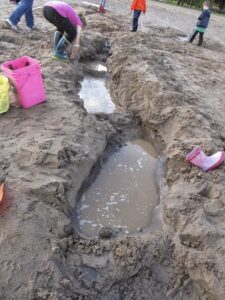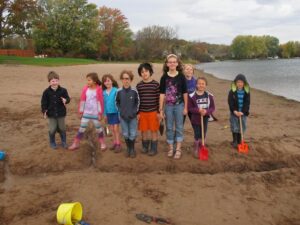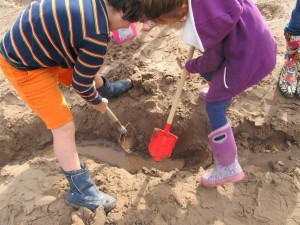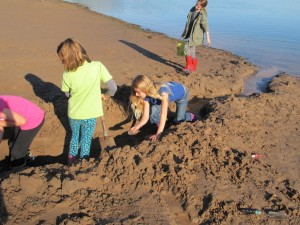For the oldest students (grades 4 and above), our study of “Mesopotamia” – the land between two rivers – began with a discussion of “How do we know what we know?” How can we possibly know about a civilization that existed over 5,000 years ago? The children displayed a solid understanding of this concept listing “artifacts, hieroglyphics, ruins, when people pass it on and on and on, pottery, scrolls, tapestries, cave drawings, books and tombs” just to name a few.
 We then looked at the words nomadic and settled, defining what each word meant. It was interesting to learn that no one knew the meaning of nomad. Again the children were very insightful when asked to list the advantages and disadvantages of each lifestyle. They could articulate how having no school could be both an advantage and a disadvantage for a nomadic child. Other advantages for the nomadic life were “You get to see the world” and “We can live wherever we want to.” Whereas the disadvantage of a settled life included, “pollution, taxes, and bills.”
We then looked at the words nomadic and settled, defining what each word meant. It was interesting to learn that no one knew the meaning of nomad. Again the children were very insightful when asked to list the advantages and disadvantages of each lifestyle. They could articulate how having no school could be both an advantage and a disadvantage for a nomadic child. Other advantages for the nomadic life were “You get to see the world” and “We can live wherever we want to.” Whereas the disadvantage of a settled life included, “pollution, taxes, and bills.”  We watched a video titled Ancient Mesopotamia, which provided a lot more information about this civilization – its religion, writing system, irrigation and life style. Assigned reading from the Cartoon History of the Universe was another way we learned about Mesopotamia. A field trip to Jamesville Beach provided a hands-on opportunity to build irrigation canals. The children were challenged to see how far they could get the water from Jamesville Lake (aka the Tigris River) to their thirsty crops. Working collaboratively, children were able to create a network of canals that reached 30 feet into the sand!
We watched a video titled Ancient Mesopotamia, which provided a lot more information about this civilization – its religion, writing system, irrigation and life style. Assigned reading from the Cartoon History of the Universe was another way we learned about Mesopotamia. A field trip to Jamesville Beach provided a hands-on opportunity to build irrigation canals. The children were challenged to see how far they could get the water from Jamesville Lake (aka the Tigris River) to their thirsty crops. Working collaboratively, children were able to create a network of canals that reached 30 feet into the sand!Children created maps to show where the Tigris and Euphrates rivers and numerous ancient cities of the region were located. We looked at modern maps and discussed the countries that exist in that region today. In the coming weeks we will be exploring how the Sumerians developed Cuneiform, their unique writing system. We will also be exploring Hammurabi’s laws, considering whether they were fair or not. Finally students will research two aspects of the Sumerian culture for an exhibit we will display at The New School.

